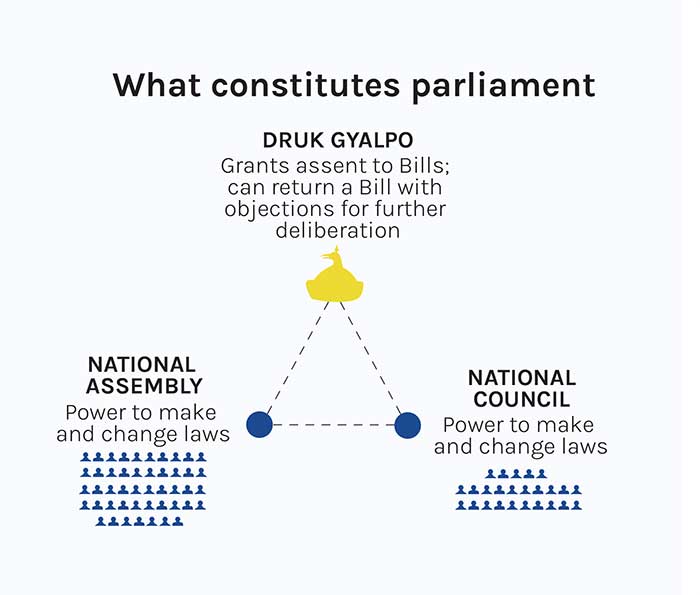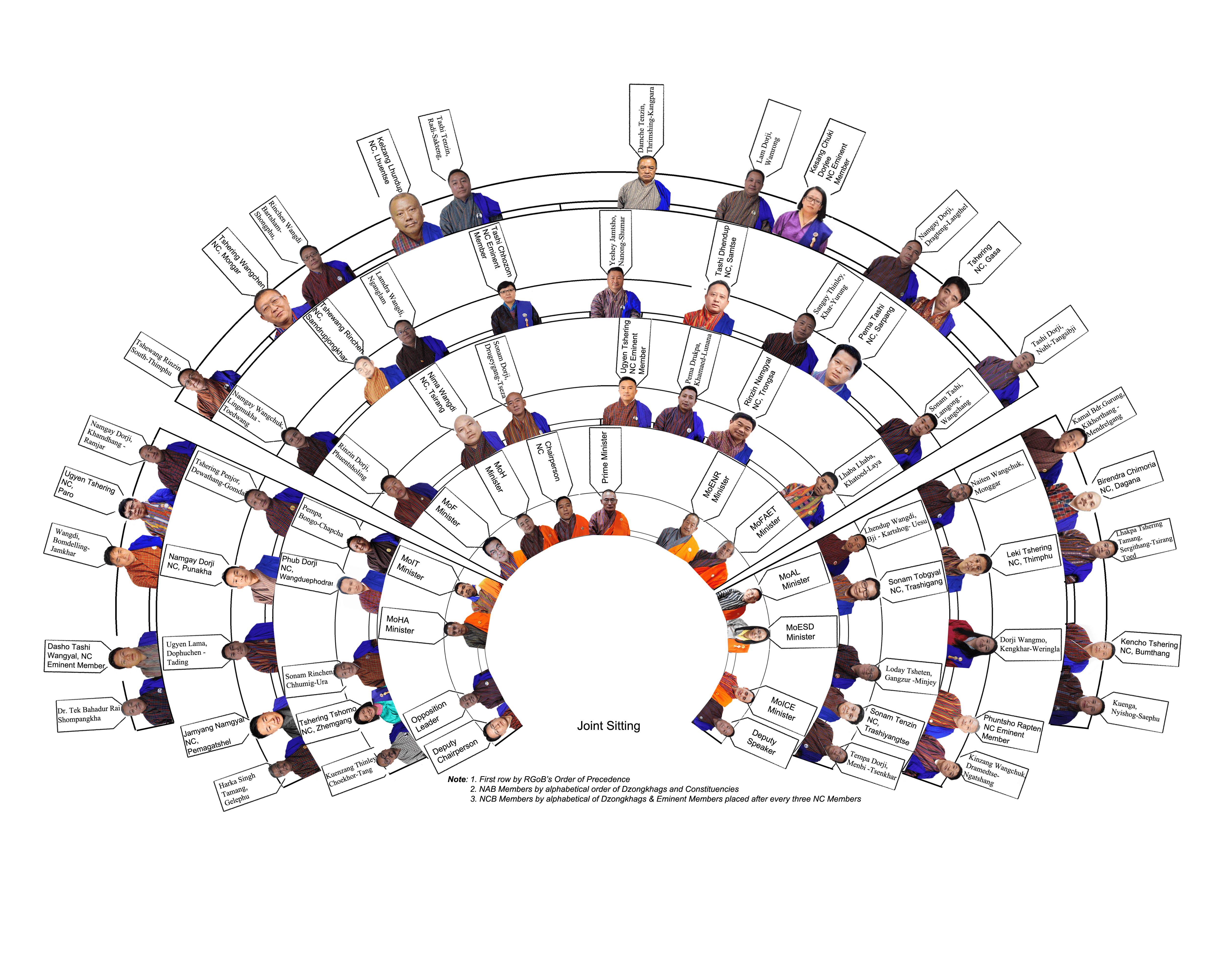About Parliament
Brief History
The beginnings of Bhutan’s Parliament go back to 1953 when Druk Gyalpo Jigme Dorji Wangchuck, established the National Assembly (tshogdu) as a forum to debate issues affecting the people, discuss development plans and record national revenues and expenditures.
The institution, which allowed people to take part in the decision-making process, started with 36 members - five representatives from the dratshang (Monastic Body), 16 nominated government officials and 15 representatives of the people. Paro Dzongtsab, Dasho Kesang Dawa, was the first Speaker.
Subsequent sessions were held in Thimphu Tashichho Dzong (2nd-13th), in Paro Rinpung Dzong (14th-28th), and then again in Tashichho Dzong (29th-73rd). Since 1993, the National Assembly sessions have been held in the present Parliament building (Gyalyong Tshogkhang).
In 1965, a six member Lodroe Tshogde or the Royal Advisory Council was formally constituted to advise the Druk Gyalpo and the Council of Ministers. The advisory body, also members of the Tshogde, supervised implementation of the policies and programmes passed by the National Assembly.
Then in 1968, the Druk Gyalpoac conceded his right to veto any decisions of the Assembly ensuring the legislative supremacy of the institution.
During the reign of the Fourth Druk Gyalpo, Jigme Singye Wangchuck, democratic decision making was further devolved to the grassroots with the creation of the Dzongkhag Yargay Tshogdu (DYT) in 1981 and the Gewog Yargay Tshogchung (GYT) in 1991.
In 1998, all executive powers were devolved to a council of ministers elected by the National Assembly for a five-year term. Since then, the Druk Gyalpo has no longer been the head of government.The Assembly was also empowered to develop a mechanism for registering a vote of confidence in the Druk Gyalpo.
In 2001, the Fourth Druk Gyalpo commanded the drafting of a constitution, and the first draft was released in 2005.
The unicameral (single chamber) National Assembly was dissolved in 2007 with the introduction of parliamentary democracy the following year when Bhutan elected its first bicameral Parliament consisting of the National Council and National Assembly.
Formation & Composition
 The
current structure of parliament with two chambers was established in 2008 under Article 11 and 12 of the
Constitution of Bhutan, 2008. It replaced the earlier National Assembly of Bhutan (Tshogdu), a unicameral
system, established in 1953. Bhutan’s parliament, consists of the Druk Gyalpo (His Majesty), the National
Council and the National Assembly.
The
current structure of parliament with two chambers was established in 2008 under Article 11 and 12 of the
Constitution of Bhutan, 2008. It replaced the earlier National Assembly of Bhutan (Tshogdu), a unicameral
system, established in 1953. Bhutan’s parliament, consists of the Druk Gyalpo (His Majesty), the National
Council and the National Assembly.
The National Council has 25 members with one member elected from each dzongkhag (district) and five appointed by the Druk Gyalpo. National Council members do not belong to any political party. Besides legislative functions, the National Council acts as the House of review on matters that need to be brought to the notice of the Druk Gyalpo, the Prime Minister and the National Assembly.
The National Assembly has 47 members elected from each of the country’s 47 constituencies or electoral areas. The members belong to either the ruling or opposition political parties. Political parties are mandated to ensure that national interests prevail over all other interests and provide choices based on the values and aspirations of the people.
Sittings
Parliament meets or sits at least twice a year in the capital, Thimphu, where parliament is located, but can convene an extraordinary sitting if commanded by the Druk Gyalpo. Each sitting of Parliament commences and closes with the Druk Gyalpo being received by members of both houses and takes place in the National Assembly Hall.
For both houses, at least two thirds of members must be present for a session to take place. Each sitting normally lasts for a month, however, the duration depends on the agenda. The sessions begin at 10 in the morning and adjourn at 1:30 pm. All proceedings are conducted in Dzongkha, the national language, and in public. There can be closed door sessions if there is a compelling need.
Joint sessions take place when there is a dispute over a proposed law from either of the houses. The Speaker of the National Assembly presides over the joint sitting, which is held in the National Assembly Hall. Disputes are usually resolved by appointing a committee comprising members of both houses and a final vote taken during the joint session.
Women in Parliament
Women's representation in the Fourth and current parliament is 4% down from 15 % in the Third Parliament. Although legislation provides equal rights and opportunities irrespective of gender, deep-rooted Socio-cultural norms continue to be the biggest barriers to women rising to leadership and decision-making positions.
Bhutan's first woman parliamentarian emerged in 1979 when the people of Chengmari, Samtse, elected Hiran Maya as their representative (chimi) to the erstwhile National Assembly, the unicameral parliament of Bhutan. She served for six years, attending 12 Assembly sessions.
Bhutan's second woman parliamentarian was (dasho) Dawa Dem, who served as a Royal Advisory Councilor from 1979 for five years. She also served as a member of the National Assembly, attending the 50th and 60th sessions. Between 1979 and 2007, 29 women were elected as people's representatives and a few as royal advisory councilors to the erstwhile National Assembly.
 English
English
 རྫོང་ཁ
རྫོང་ཁ



